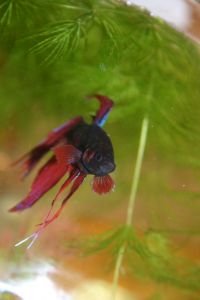 Finding out about correct beta fish care is vital for any people who have taken the interest of being a betta fish owner. One of the areas which many people fail to take note of, resulting in their betta fish growing unhappily, is the native habitat of the beta fish as well as the living conditions in which these wonderful fish breed and thrive. Without knowing these things, you risk overlooking the basics of proper beta fish care.
Finding out about correct beta fish care is vital for any people who have taken the interest of being a betta fish owner. One of the areas which many people fail to take note of, resulting in their betta fish growing unhappily, is the native habitat of the beta fish as well as the living conditions in which these wonderful fish breed and thrive. Without knowing these things, you risk overlooking the basics of proper beta fish care.
Beta fish, also known as betta fish or even Siamese fighting fish, are one of the most lovable and captivating tropical fishes. Due to their unique characteristics and personalities, they have been known as one of the first preferences for people interested in rearing freshwater fishes. They are famously prized for their grand and beautiful colours, and their capacity to survive in regions with small amounts of water, unlike many other fish.
Beta fish originally came from the regions of Thailand, from which comes their name as Siamese fighting fish. Usually found in areas such as shallow rich paddies places or stagnant pools, they commonly survive in regions with low amounts of oxygen in the water. Therefore, when taking into consideration beta fish care and the important requirements of taking care of a betta fish, it is essential to take into consideration it’s native habitat and origins. Experts in the area of beta fish care and beta fish breeding have been able to produce great variety in the range of colours and patterns of the beta fish in recent years, and so finding a beautiful beta to match your home’s color is not as tough as it can be with other tropical fish.
Returning to the subject of beta fish habitat, you can often observe betta fish being displayed and sold in very tiny fish cups or containers in fish shops, and as a result most people carry on the trend by placing their betta fish in very tiny cups after buying them. On the contrary, it would probably be a wise choice to introduce your betta fish to a much larger beta fish tank instead of confining it in little small cups which take away a large portion of its freedom to move.
Essential areas on beta care include understanding how one must properly handle their beta fish tanks or beta fish bowls. Testing the level of acidity of the water in a betta fish tank should be done regularly, and a well quoted pH range that betta’s are said to prefer is between the level of 6.8 and 7.4, with a hardness of lower than 20 dGH.
Part of the reason why beta fish are known to be able to live in conditions of low oxygen is due to the fact that they swim up and breathe oxygen from the water’s surface, rather than depending on the amount of dissolved oxygen in the water. Considering this, you need to remember to let your beta fish to have a passage to come up to the surface of the water and breathe for oxygen or else they’ll drown.
However, protecting the blocking top of the tank, you still have to put some type of cover or lid with air holes in it, as beta fish are very able to jump. And if you did not place a cover or lid over top of the tank, your beta fish may any day jump straight of their beta fish tank or beta fish bowl and perish when you are not there to save it…
There are a lot of things you need to know and learn about caring for beta fish as a betta fish owner… probably more than you thought… A good place that I discovered where you can find good beta fish info as well as other betta fish resources is below. It covers things like beta fish food, beta fish tanks, and more. Click the link below and visit the site: